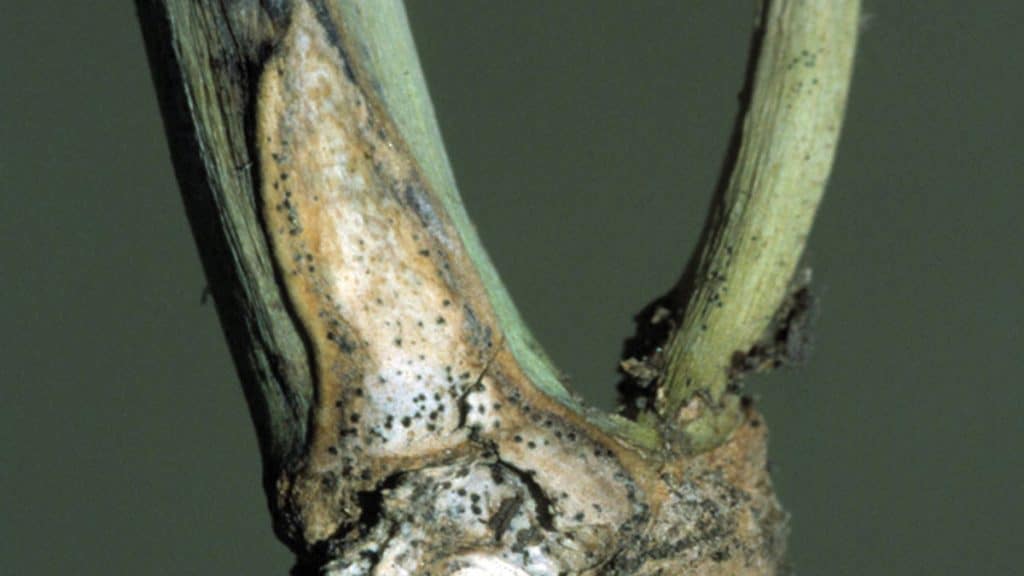_x000D_
According to the Canola Council of Canada, while blackleg hasn’t cost extensive yield loss in recent years, it has the potential to cause significant yield loss again if it isn’t managed carefully. Survey results suggest that blackleg incidence is on the rise, and this disease can become a trade barrier to canola markets that are sensitive to the fungus that causes it — Leptosphaeria maculans._x000D_
_x000D_
“There’s no doubt that over the past several decades, blackleg has been an ongoing threat to canola production in Western Canada,” says Trevor Blois, a disease diagnostician at 20/20 Seed Labs. “With the introduction of resistant varieties, we gained an important tool in managing the pest._x000D_
_x000D_
“However, the push for shorter rotations combined with the adaptability of the pathogen and lack of common knowledge about the specific resistances available in different canola varieties has resulted in virulent strains of the pathogen, capable of infecting resistant hosts.”_x000D_
_x000D_
Gary Peng, a research scientist at Agriculture and Agri-Food Canada’s Saskatoon Research Centre, says that although it’s not easy to generalize the blackleg situation accurately across the Prairies due to yearly and regional variations, provincial survey data have highlighted southern Manitoba, east-central Alberta and northwest Saskatchewan as regions with higher levels of blackleg in recent years._x000D_
_x000D_
“When averaged over the province, blackleg levels did increase steadily in the past five years, although the cause is still not entirely clear,” he says._x000D_
_x000D_
To stay ahead of the disease and manage it effectively into the future, the Canola Council of Canada formed a Blackleg Steering Group, which developed and released, in December of 2013, a “Blackleg Strategic Plan in Canada” that outlines research and Extension efforts that are needed._x000D_
_x000D_
According to the strategic plan, “the canola industry in the past has relied on blackleg resistance as the main method for controlling this disease. But that method may not provide durable control into the future. To stay ahead of blackleg, the canola industry needs to engage in a collaborative approach to manage this disease; to develop new tools for control; and to develop consistent messaging for management for canola growers. Through multiple venues, targets for research and disease Extension messaging have been developed.” The plan outlines research priority areas, including:_x000D_
- _x000D_
- Find new sources of blackleg resistance.
- Identify and survey races/avirulence genes in L. maculans in Canada to measure and monitor their distribution over time.
- Identify major resistance genes in commercial cultivars of B. napus.
- Quick field diagnostics to identify the presence of L. maculans avirulence genes in the field.
_x000D_
_x000D_
_x000D_
_x000D_
_x000D_
Focus on Research
_x000D_
Seed companies and government research institutions are jumping in to help. Collaborations between AAFC’s Peng and Dilantha Fernando at the University of Manitoba found that blackleg resistance in Western Canada might be conferred by both major-gene and quantitative (adult-plant) resistance, with less than 70 per cent of the cultivars carrying the specific resistance gene Rlm3 and 56 per cent showing adult-plant resistance._x000D_
_x000D_
“Other specific resistance genes, however, are uncommon,” says Peng. “Analyses of pathogen race structure in the past several years showed that Rlm3 would no longer be effective against blackleg, and it might be the adult-plant resistance that did the heavy lifting for most canola cultivars.
_x000D_
“This type of resistance can be more persisting, but it alone might not be robust enough, and might fail under certain conditions.”_x000D_
_x000D_
Peng adds that based on their research, the resistance genes Rlm2, Rlm4, Rlm6 and Rlm7 should be highly effective. “It is expected that seed companies actively incorporate these specific R genes into their adult-plant resistance background, and this is likely the optimal strategy for durable host resistance.”_x000D_
_x000D_
Syngenta introduced its first canola hybrid with multi-gene blackleg resistance this past summer._x000D_
_x000D_
“Genetics are still the primary management tool and, in August, we brought to market our first canola hybrid with multi-gene blackleg resistance, SY4157,” says Mike Hutton, product evaluation scientist for oilseeds with Syngenta. “This is a step up from the predominant single gene resistance and has held up better under heavy blackleg infection. Blackleg is a significant focus for Syngenta and we will continue to develop products to help manage it.”_x000D_
On the Rise
_x000D_
This table shows the prevalence and incidence of blackleg on the prairies between 2010 and 2014. Source: Canola Council of Canada._x000D_
| Manitoba | Saskatchewan | Alberta | ||||
|---|---|---|---|---|---|---|
| Prevalence | Incidence | Prevalence | Incidence | Prevalence | Incidence | |
| 2010 | 57.8% | 7.6% | 41.5% | 2.9% | 53.4% | 8.7% |
| 2011 | 59% | 9% | 24% | 1.4% | 66% | 5.4% |
| 2012 | 77% | 12% | 32% | 3.7% | 98% | 21.2% |
| 2013 | 75% | 17% | 25% | 2% | No Data | No Data |
| 2014 | 93% | 24.4% | 54% | 14% | No Data | No Data |
_x000D_
_x000D_
Management Matters
_x000D_
In addition to a renewed focus on blackleg research and the development of varieties with new resistance traits, communication of proper management practices is critical to ensuring blackleg doesn’t once again cripple Canadian canola fields._x000D_
_x000D_
Breakdown of disease resistance is not a new problem in crop production, and according to Blois it just needs to be managed properly to prevent widespread blackleg infection of resistant varieties._x000D_
_x000D_
“One of the most promising ways to manage the pest is the Australian approach that involves rotating between different varietal resistances to prevent the pathogen population from adapting to a singular resistance in large numbers,” he says. “We look forward to seeing this approach get rolled out in Canada.”_x000D_
_x000D_
Hutton agrees. “Blackleg is manageable but there are increasing cases of resistance breakdown,” he says. “This seems to be occurring as a result of a reliance on limited genetics in tighter canola rotations, with limited support from other agronomic practices.”_x000D_
_x000D_
Hutton cautions that blackleg is likely under diagnosed, as well. “The best time to scout for infection is around harvest, when time is at a premium, and often the visible symptoms can be mistaken for another disease or simply some early maturing areas of a field. If we manage blackleg with all of the available tools, there is opportunity to keep it in check, in Canada, but Australia has experienced a much larger problem in recent years.”_x000D_
_x000D_
Peng has seen the damage blackleg can do firsthand in his extensive research trials. He says under the current circumstance, producers should be vigilant. “A very simple thing to do is to monitor blackleg in their own fields by clipping 50-100 lower stems after swathing and checking the incidence/severity of blackleg,” he says. “If the disease is present on more than 30 per cent of plants, with an average severity greater than 1.5, then it means the cultivar resistance is eroding and there is a huge amount of pathogen inoculum available in the field to attack the next canola crop. Extending the crop rotation and changing canola cultivars should be considered in this situation.”_x000D_
Don’t Forget About Seed Testing
_x000D_
A perhaps underused management method for fighting blackleg is seed testing. “It’s very important get your seed tested because even if you’re extremely cautious with maintaining long rotations, you can still introduce the pathogen by seed,” Blois says._x000D_
According to Blois, transmission on seed, up to now, has been a relatively low risk. During the past eight years, only about 6.5 per cent of samples tested by 20/20 Seed Labs came back positive for blackleg._x000D_
_x000D_
“Once in a field though, the blackleg pathogen can overwinter on infected stubble for three to five years,” Blois says. “It’s for this reason, and the obvious potential economic losses, that I say blackleg is the singular most important pathogen to test your canola seed for in Western Canada.”_x000D_
_x000D_
In addition, Blois adds that the fungus that causes blackleg, Leptosphaeria maculans, continues to be listed as a pest under the Province of Alberta’s Agricultural Pests Act._x000D_
_x000D_
“Any seed that is being planted in Alberta should be tested and shown to be disease free,” he says. “This could mean some short-term losses for farmers, whether from longer rotations or buying new seed and new varieties, in order to maintain long-term gains by preventing the disease from taking hold and decimating a future crop.”_x000D_
_x000D_
Blois says 20/20 has two different methods to test seed and plant tissue for blackleg — a traditional plant pathology method, which can take between one to three weeks to complete, and a molecular test that takes 24-48 hours to complete._x000D_
_x000D_
“Blackleg can be a devastating disease,” Blois says. “While it may be only one small part of the considerations that growers need to make throughout a year, the old adage ‘you reap what you sow’ rings true, which is why planting disease free, vigorous seed is of the utmost importance.”_x000D_
Implement an Integrated stewardship Approach
_x000D_
Peng says there is no silver bullet for the stewardship of the tools to cope with blackleg — it comes down to a combination of new varieties and better management practices._x000D_
_x000D_
“Cultivar resistance is key to blackleg management and new cultivars with different R genes or R-gene combinations will likely be available in the not too distant future,” he says. “However, the pathogen will eventually adapt to any resistance genes employed, and best management practices are irreplaceable. We will continue to monitor the pathogen race structure across the prairies to provide industry with up to date information on which R genes will likely work or not work for blackleg resistance breeding,” Peng says. “For producers, checking the disease on their farms and rotating crops/cultivars will help mitigate the risk of blackleg epidemics.”_x000D_
_x000D_
Hutton agrees that there are various stewardship practices. “With canola rotations remaining tight, an integrated approach is becoming more important,” says Hutton. “Field scouting is key to understanding the risk, at a field level._x000D_
_x000D_
“Crop rotation, genetics and fungicide are all important tools to manage blackleg infection and inoculum buildup. There will be more multi-gene blackleg resistant hybrids coming to market and, likely, a greater diversity of genes incorporated but genetics are only part of the puzzle.”_x000D_
Communication is Key
_x000D_
Seed companies and retailers are in the best position to educate farmers on proper blackleg management. Blackleg infection is initiated by spores released from infected canola residue or stubble. You can help by educating farmer customers on these practices from the Canola Council of Canada to keep the disease from impacting yield and profitability, and to reduce the presence of blackleg on seed._x000D_
- _x000D_
- Plant only R (resistant) or MR (moderately resistant) rated canola varieties. All canola varieties are rated for resistance to blackleg.
- Scout canola fields regularly for blackleg symptoms and prevalence. This information will help determine the effectiveness of your blackleg management plan.
- Maintain a break between canola crops to allow time for crop residue to decompose. If blackleg becomes established in the field, a minimum break of two to three years is recommended.
- Plant certified treated seed. It’s the first step in keeping fields clean.
- Rotate varieties to bring a mix of blackleg resistance genes to the field over time, which can prevent or delay the breakdown of resistance.
- Consider applying a fungicide if the disease is identified early in the season.
- Control volunteer canola and other brassica weeds (stinkweed, shepherd’s purse, wild mustard and flixweed) to prevent blackleg build-up during non-canola years.
_x000D_
_x000D_
_x000D_
_x000D_
_x000D_
_x000D_
_x000D_
_x000D_











